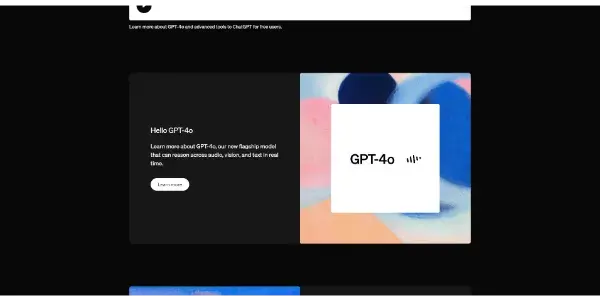GPT-4o

Discover GPT-4o, OpenAI's new flagship model. It analyzes audio, vision and text in real time, for increasingly natural interaction with AI
GPT-4o: A Multimodal Leap Forward in AI Interaction
GPT-4o (note: there is currently no publicly released AI model with this name. This response is based on the provided prompt description and speculates on what such a model might offer.) represents a hypothetical significant advancement in large language model (LLM) technology. OpenAI's purported flagship model, GPT-4o, distinguishes itself through its ability to analyze and process audio, visual, and textual data in real-time, leading to a more natural and intuitive interaction with artificial intelligence.
What GPT-4o Does
Unlike previous generations of LLMs primarily focused on text processing, GPT-4o aims for a truly multimodal experience. This means it can understand and respond to a combination of audio inputs (speech, music), visual inputs (images, videos), and text simultaneously. This integrated approach allows for a richer understanding of context and more nuanced responses. The model doesn't just process each input type separately; it integrates them to create a comprehensive understanding of the situation.
Main Features and Benefits
- Real-time Multimodal Processing: The core feature is the real-time analysis of audio, visual, and textual data. This eliminates delays and allows for fluid conversations and interactions.
- Enhanced Contextual Understanding: By integrating different data types, GPT-4o can achieve a deeper understanding of context, leading to more accurate and relevant responses. Imagine describing an image while simultaneously providing textual details—GPT-4o could synthesize this information for a comprehensive response.
- Improved Natural Language Generation: The multimodal input enriches the model's output, resulting in more natural-sounding and contextually appropriate text, translations, and summaries.
- Increased Accessibility: The inclusion of audio and visual processing can make AI more accessible to users with diverse needs, including those with visual or auditory impairments.
Use Cases and Applications
The capabilities of GPT-4o open doors to numerous applications across various sectors:
- Customer Service: Imagine a customer service chatbot that can understand a customer's query through text, voice, and even an image of a faulty product. This would drastically improve the efficiency and effectiveness of support.
- Education: GPT-4o could analyze student work (text, images, audio recordings) to provide personalized feedback and support, adapting to different learning styles.
- Healthcare: Analyzing medical images alongside patient records and doctor's notes could assist in diagnostics and treatment planning.
- Accessibility Technologies: Real-time transcription and translation services, coupled with visual scene description, could significantly enhance accessibility for individuals with disabilities.
- Creative Industries: Artists and designers could use GPT-4o to generate creative content based on textual descriptions and visual inspirations.
Comparison to Similar Tools
While existing LLMs can process some multimodal data, GPT-4o's purported real-time, integrated approach sets it apart. Tools like DALL-E 2 (image generation) and Whisper (speech-to-text) excel in their specific domains, but GPT-4o's strength lies in its unified processing of diverse input types. This holistic approach allows for more complex and nuanced interactions than individual specialized tools.
Pricing Information
According to the provided information, GPT-4o is currently offered free of charge. However, this may change as the model matures and its applications expand. Future pricing models may involve tiered access based on usage or specific features.
Disclaimer: It's crucial to remember that GPT-4o, as described, is a hypothetical model. The information presented here is based on the prompt's description and explores the potential capabilities of such a tool. No publicly available information currently confirms the existence or specifics of an OpenAI model named GPT-4o.